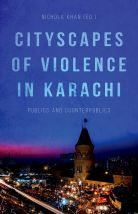Cityscapes of Violence in Karachi: Publics and Counterpublics

Cityscapes of Violence in Karachi is no ordinary study of one “type” of violence in Karachi from one particular perspective. Rather, it gives voice to explorations of violence across many facets.
Cityscapes of Violence starts with a preface that outlines the transformation of Karachi’s geographical, ethnic and political landscape following its exponential growth and immigration explosion after the British Partition of India in 1947. Of major significance to the book is the formation of the Mohajir Qaumi Movement (MQM) in 1984 and subsequent events that catalysed Mohajir–Pashtun violence and rising Pakistani Taliban power. This has formed an intricate and ongoing web of violence bound up in politics, which frames the context of this book.
The introduction, written by editor Nichola Khan, outlines why Karachi is the city of study. She also explains her experimental and analytical approach of bringing together diverse specialist insights on violence in Karachi, explores how this engagement of specialists informs one another, and encourages “the creation of wider publics and counterpublics” through a shift away from the “purely academic” (page 5).
The main content of the book includes 10 unique chapters written by a diverse selection of authors, as highlighted above. Chapter 1 locates Karachi in the poetry of Azra Abbas. As a poet her writings reveal how violence is present in both the smaller and larger configurations of urban life. Through translating and unpicking 11 of her poems, this chapter explores violence that is embedded in the everyday experiences of Karachi’s inhabitants.
In Chapter 2 the author draws upon his anthropological research of Liquatabad District in Karachi during 1994. He describes Liquatabad as a “historical theatre of intermittent conflict” spanning three decades from the 1960s–1990s, and in this chapter reflects on questions of madness related to violence and politics (page 41).
Drawing upon “political economic, social, and demographic connections between historical and contemporary analyses”, Chapter 3 develops the controversial claim, first made by Dr Bengali in 2014, that Karachi will become a Pashtun-majority city (page 64).
Chapter 4 analyses how militant activities often take on a part-time nature in Karachi, where armed fighters are employed episodically alongside political events.
Chapter 5 stems from fieldwork carried out in Lyari – a no-go area of Karachi known for violence and criminality. This chapter particularly focuses “on ways residents narrated their own experiences of violence and fear within and outside their locality” (page 106).
Contrasting movements MQM and the Dawat-i-Islami are the focus of Chapter 6. Here the author describes their similarities and differences: namely how they represent political and religious movements, respectively, yet both compete for the support of young Mohajir males and both incorporate elements of popular Mohajir religiousity (page 124).
In Chapter 7 the author reflects on his own experience with alcohol, to highlight and examine “a much neglected and maligned political history surrounding alcohol, getting drunk, and prohibition in Karachi” (page 135). This describes how after the ban on alcohol in 1977, drinking alcohol and getting drunk became one of the most rebellious acts for youths who detested Zia’s dictatorship in Karachi. It also became a “medicine” for political activists who experienced torture and imprisoning.
Chapter 8 examines the challenges and sacrifices for journalists practising in or writing about Karachi. It highlights the red line that journalists know they cannot cross and the fraught relationship between political parties and the media. Beginning with a historical documentation of how Zia’s dictatorship led to a demise in Karachi’s cosmopolitanism,
Chapter 9 explores indications of its revival. Concomitantly, it urges caution as this revival is accompanied by the reproductions of social hierarchies of class and privilege (page 173).
To end, Chapter 10 reflects upon four “ordinary” deaths of Karachiites, who were brutally killed in 2013. Here the author queries how pain, anger, and incomprehension of killings can contribute to transformative civil society responses out of a desire to bring good from bad.
Book note prepared by Hannah Keren Lee
Search the Book notes database
Our Book notes database contains details and summaries of all the publications included in Book notes since 1993 - with details on how to obtain/download.
Use the search form above, or visit the Book notes landing page for more options and latest content.
For a searchable database for papers in Environment and Urbanization, go to http://eau.sagepub.com/

